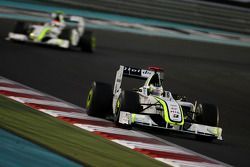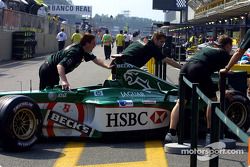How to buy a $100million F1 team for just one pound
Renault didn't pay much for the Lotus F1 team, but now the investment really has to begin if its to regain its F1 World Championship-winning ways, says Charles Bradley.

Photo by: XPB Images



















So how much does a Formula 1 racing team cost to buy? The answer we got this week is: one English sterling pound, i.e. roughly $1.50. That is exactly how much French car giant Renault paid to buy the Lotus F1 Team.
But how can this be? Running an F1 team, after all, costs between $70million (for the smallest private team) to $300million (for the likes of Ferrari, which builds its own cars and engines).
Somewhere in-between is Lotus, which previously bought its engines from Mercedes for over $10million a year as part of its $100million budget to compete in the world’s premium motorsport series.
The company that owned Lotus was repeatedly in the British High Court this year, with Her Majesty’s Revenue and Customs (the UK’s IRS) chasing a $4million tax bill.
And this, in part, is the reason why Lotus was de jure sold for a meager golden coin, rather than a fistful of millions.
It wasn't just that, of course - there were also huge corporate debts involved here, with the previous owners retaining a 10% stake in the rebranded Renault F1 team, rather than a majority stake in one that was highly likely to go bust.
It’s not unusual
So is it uncommon for a team that turns over that much cash to be sold for a nominal cash fee? No, not really.
The most recent case was the sale of the Honda team to former Ferrari technical chief Ross Brawn in 2008, who formed the Brawn GP team - the team that then won the following year’s F1 World Championship with Jenson Button.
Honda had spent a fortune getting it wrong, even with Brawn at the helm. But following a last-gasp management buy-out as the Japanese manufacturer exited the sport, Brawn GP flourished in spectacular style after securing a Mercedes engine deal and spotting a loophole in the regulations.
By the end of that super-successful season, Mercedes bought out the company – then turning it into the factory team with which Lewis Hamilton has won the last two world titles.
That deal is probably the quickest multi-million dollar profit any race team proprietor has ever made, and if Mr. Brawn wasn’t rich enough already – he certainly was now...
Adding fizz to F1
A few years before that motorsport miracle, Red Bull bought the ailing Jaguar F1 team from the Ford Motor Company for just one dollar.
Get this: a fizzy drinks firm then turned F1’s biggest-spending underachievers into a four-time F1 World Champion team – and using an off-the-shelf Renault engine to do it.
In its previous 85 races, owned by one of the planet’s biggest car manufacturers, the Jaguar team had led a paltry two laps… Its rebranded successor, Red Bull Racing, has subsequently led 3075 laps!
Part of the deal, of course, was that Red Bull pledged to invest a minimum of £200million over the following three years. It also signed design genius Adrian Newey, and developed star driver Sebastian Vettel from a promising teenager into a grand prix great.
Sure it took a while, but sensible growth and a willingness to reinvest created an F1 giant that even bought a second team, Minardi, just to develop drivers for its A-squad.
In short, it pulled off some smart deals and reaped the benefit.
What lessons can Renault learn?
Renault’s recent years in F1 have been a true rollercoaster. As a manufacturer team, it has scored 35 wins since 1979 – back when it revolutionized the use of turbochargers in the sport.
It has twice claimed the F1 World Championship – with Fernando Alonso in 2005/06 – up against the staunchest of opposition in Michael Schumacher and Ferrari. As an engine manufacturer, Renault has 12 world titles to its name – thanks also to collaborations with Benetton, Williams and Red Bull – eclipsed only by the mighty Ferrari in championship terms.
Its terrible past two seasons with Red Bull, which publicly criticized Renault’s product and efforts to fix it, have led to its return as the master of its own destiny.
The team it has purchased, Lotus, is actually the same Enstone-based outfit that it sold in 2009 (having first bought it in 2000) and won those two titles with. You can trace that operation back to its roots as Toleman, made famous as the great Ayrton Senna’s first F1 team.
And here lies the issue: manufacturers come and go in F1 as it suits them. The costs of competing are enormous, but only they (and sovereign states or billionaires or oligarchs) have the wherewithal to foot those astronomical bills. Until, that is, they don’t get the results on the racetrack, which is when the boardroom questions why they’re in it if they aren’t winning – having forgotten why they were doing it in the first place.
When you think about it, buying an F1 team for a pound or a dollar is actually less ridiculous as spending hundreds of millions on running it, for the costs of competition have escalated to unprecedented heights. Only the super-rich need apply here.
Renault says it is now committed to becoming “one of the big boys” once more in F1; to do that is going to take many more pound coins than it spent on Lotus.
Be part of Motorsport community
Join the conversationShare Or Save This Story
Subscribe and access Motorsport.com with your ad-blocker.
From Formula 1 to MotoGP we report straight from the paddock because we love our sport, just like you. In order to keep delivering our expert journalism, our website uses advertising. Still, we want to give you the opportunity to enjoy an ad-free and tracker-free website and to continue using your adblocker.



















Top Comments